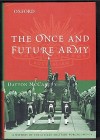The Once and Future Army: A History of the Citizen Military Forces 1947–1974
Written by: Dayton McCarthy,
Oxford University Press, Melbourne, 2003,
ISBN: 9780195515695, 303pp.
Reviewed by: Alan Ryan, Senior Research Fellow, Land Warfare Studies Centre
This excellent book is required reading for anyone who wants to understand how our present-day Army came to be. In that sense it is not only a history of the Army’s reserve forces since the end of World War II, but it is also an account of how the Army as a whole adjusted to the complex realities of the Cold War. It is clear from this account that various lobby groups fought hard and long for their vision of the future Army, and that we still live with the result of their reasoning, passions and prejudices.
When it comes to making an Army, nothing is ‘meant to be’. However, in retrospect we can learn much from the decisions and most importantly the errors of the past. For those with any experience of force structure planning it is disheartening to see how often we have faced the same problems and made the same mistakes. This book contains a warning to future force-planners, policy-makers, strategists and politicians that the Army is bigger than any of them. Perhaps most importantly, if we want the Army to be capable of undertaking the tasks we place on it, we need to pay more attention to what Wellington called ‘that article’—the soldier. Anything else—whether it is tradition, professional pride, social ambition or political patronage—is just baggage.
One might gather from the foregoing that this book is an interesting read. In a way this is surprising, because it started life as a doctoral thesis, which the author completed at the Australian Defence Force Academy. This reviewer had the privilege to read the original thesis, which was a first-class piece of scholarship. Dayton McCarthy has done an excellent job of translating his research and turning his academic dissertation into an accessible and gripping book.
The book effectively picks up where Craig Wilcox’s history of citizen soldiering in Australia left off. Wilcox brought his book to a close at the end of World War II and only made some brief observations about the Citizen Military Forces (CMF) in the postwar period. McCarthy picks up the reformation of the Australian Army and takes it through to the Millar Inquiry in 1974, which resulted in the wholesale restructure of the part-time component of the Army. He even goes a little further—the all-too-brief conclusion provides one of the best summaries of force structure development over the past thirty years that is available.
McCarthy uses the story of the rise and fall of the postwar CMF to chart the progress of Australia’s changing strategic priorities and defence needs. The book is a catalogue of a widening gap between aspirations and reality. Because of resource constraints, CMF part-timers had to operate within a framework of limitations. The resulting lack of credibility was a shocking testimony to a wasted national resource and an insult to those who committed a large portion of their lives to voluntary national service.
The book demonstrates that ‘a combination of government inaction, military bureaucratic disinterest, and a partial failure by the CMF to adapt to changing defence environments, coupled with societal ambivalence towards it, reduced the strength, role and prestige of the CMF between 1947 and 1974’. Sadly, there are few villains and quite a few flawed heroes. What is clear is that few involved with the Army had a large enough vision to see how the regular and part-time components could complement and supplement each other to achieve the common mission. The failure to use the CMF as a source of manpower during the Vietnam War was fatal to the ‘one Army’ concept. It is particularly interesting to read how the CMF Member of the Military Board, Major General Paul Cullen, campaigned to get a CMF battalion to Vietnam. The subsequent development of the Army might have been very different had he succeeded.
One of the most interesting themes in the book is McCarthy’s analysis of the concept of the ‘brilliant amateur’. This idea was built on the performance of the citizen soldiers of the First and Second AIFs. The idea that a trained citizen could rapidly deploy on operations was a sustaining myth for the part-timers in their darkest times. It was a notion founded on historical reality. The postwar leadership of the CMF was not short of inspirational officers and non-commissioned officers who possessed extraordinary experience of battle in theatres around the world. However, the tempo of operations in Korea and the counterinsurgency campaigns of the 1950s and 1960s favoured the regular army, so that over that period the balance of professionalism finally and irrevocably shifted to the regulars.
McCarthy ends the book on an up-beat note. The notion of a mass citizen army organised as the basis for national mobilisation to fight an industrial-age war has now been abandoned. Reservists are finally an essential part of the total force. Not only do they represent a ‘surge’ capacity to enable the Army to sustain operations at a time of high operational demand, but they possess many essential skill-sets that the Army cannot afford to maintain on a full-time basis. As the intellectual demands of complex information-age conflict proliferate, there will be an even greater demand to utilise the skills of citizen soldiers. Perhaps most importantly, we should not be thinking about ‘surge’ capacity—which suggests a short-term, limited commitment. If the signs are right, we may need access to an assured supply of short-service, part-time professionals to meet the operational demands of an uncertain future.


